3.08: Nucleic Acids
- Page ID
- 92580
\( \newcommand{\vecs}[1]{\overset { \scriptstyle \rightharpoonup} {\mathbf{#1}} } \)
\( \newcommand{\vecd}[1]{\overset{-\!-\!\rightharpoonup}{\vphantom{a}\smash {#1}}} \)
\( \newcommand{\dsum}{\displaystyle\sum\limits} \)
\( \newcommand{\dint}{\displaystyle\int\limits} \)
\( \newcommand{\dlim}{\displaystyle\lim\limits} \)
\( \newcommand{\id}{\mathrm{id}}\) \( \newcommand{\Span}{\mathrm{span}}\)
( \newcommand{\kernel}{\mathrm{null}\,}\) \( \newcommand{\range}{\mathrm{range}\,}\)
\( \newcommand{\RealPart}{\mathrm{Re}}\) \( \newcommand{\ImaginaryPart}{\mathrm{Im}}\)
\( \newcommand{\Argument}{\mathrm{Arg}}\) \( \newcommand{\norm}[1]{\| #1 \|}\)
\( \newcommand{\inner}[2]{\langle #1, #2 \rangle}\)
\( \newcommand{\Span}{\mathrm{span}}\)
\( \newcommand{\id}{\mathrm{id}}\)
\( \newcommand{\Span}{\mathrm{span}}\)
\( \newcommand{\kernel}{\mathrm{null}\,}\)
\( \newcommand{\range}{\mathrm{range}\,}\)
\( \newcommand{\RealPart}{\mathrm{Re}}\)
\( \newcommand{\ImaginaryPart}{\mathrm{Im}}\)
\( \newcommand{\Argument}{\mathrm{Arg}}\)
\( \newcommand{\norm}[1]{\| #1 \|}\)
\( \newcommand{\inner}[2]{\langle #1, #2 \rangle}\)
\( \newcommand{\Span}{\mathrm{span}}\) \( \newcommand{\AA}{\unicode[.8,0]{x212B}}\)
\( \newcommand{\vectorA}[1]{\vec{#1}} % arrow\)
\( \newcommand{\vectorAt}[1]{\vec{\text{#1}}} % arrow\)
\( \newcommand{\vectorB}[1]{\overset { \scriptstyle \rightharpoonup} {\mathbf{#1}} } \)
\( \newcommand{\vectorC}[1]{\textbf{#1}} \)
\( \newcommand{\vectorD}[1]{\overrightarrow{#1}} \)
\( \newcommand{\vectorDt}[1]{\overrightarrow{\text{#1}}} \)
\( \newcommand{\vectE}[1]{\overset{-\!-\!\rightharpoonup}{\vphantom{a}\smash{\mathbf {#1}}}} \)
\( \newcommand{\vecs}[1]{\overset { \scriptstyle \rightharpoonup} {\mathbf{#1}} } \)
\( \newcommand{\vecd}[1]{\overset{-\!-\!\rightharpoonup}{\vphantom{a}\smash {#1}}} \)
\(\newcommand{\avec}{\mathbf a}\) \(\newcommand{\bvec}{\mathbf b}\) \(\newcommand{\cvec}{\mathbf c}\) \(\newcommand{\dvec}{\mathbf d}\) \(\newcommand{\dtil}{\widetilde{\mathbf d}}\) \(\newcommand{\evec}{\mathbf e}\) \(\newcommand{\fvec}{\mathbf f}\) \(\newcommand{\nvec}{\mathbf n}\) \(\newcommand{\pvec}{\mathbf p}\) \(\newcommand{\qvec}{\mathbf q}\) \(\newcommand{\svec}{\mathbf s}\) \(\newcommand{\tvec}{\mathbf t}\) \(\newcommand{\uvec}{\mathbf u}\) \(\newcommand{\vvec}{\mathbf v}\) \(\newcommand{\wvec}{\mathbf w}\) \(\newcommand{\xvec}{\mathbf x}\) \(\newcommand{\yvec}{\mathbf y}\) \(\newcommand{\zvec}{\mathbf z}\) \(\newcommand{\rvec}{\mathbf r}\) \(\newcommand{\mvec}{\mathbf m}\) \(\newcommand{\zerovec}{\mathbf 0}\) \(\newcommand{\onevec}{\mathbf 1}\) \(\newcommand{\real}{\mathbb R}\) \(\newcommand{\twovec}[2]{\left[\begin{array}{r}#1 \\ #2 \end{array}\right]}\) \(\newcommand{\ctwovec}[2]{\left[\begin{array}{c}#1 \\ #2 \end{array}\right]}\) \(\newcommand{\threevec}[3]{\left[\begin{array}{r}#1 \\ #2 \\ #3 \end{array}\right]}\) \(\newcommand{\cthreevec}[3]{\left[\begin{array}{c}#1 \\ #2 \\ #3 \end{array}\right]}\) \(\newcommand{\fourvec}[4]{\left[\begin{array}{r}#1 \\ #2 \\ #3 \\ #4 \end{array}\right]}\) \(\newcommand{\cfourvec}[4]{\left[\begin{array}{c}#1 \\ #2 \\ #3 \\ #4 \end{array}\right]}\) \(\newcommand{\fivevec}[5]{\left[\begin{array}{r}#1 \\ #2 \\ #3 \\ #4 \\ #5 \\ \end{array}\right]}\) \(\newcommand{\cfivevec}[5]{\left[\begin{array}{c}#1 \\ #2 \\ #3 \\ #4 \\ #5 \\ \end{array}\right]}\) \(\newcommand{\mattwo}[4]{\left[\begin{array}{rr}#1 \amp #2 \\ #3 \amp #4 \\ \end{array}\right]}\) \(\newcommand{\laspan}[1]{\text{Span}\{#1\}}\) \(\newcommand{\bcal}{\cal B}\) \(\newcommand{\ccal}{\cal C}\) \(\newcommand{\scal}{\cal S}\) \(\newcommand{\wcal}{\cal W}\) \(\newcommand{\ecal}{\cal E}\) \(\newcommand{\coords}[2]{\left\{#1\right\}_{#2}}\) \(\newcommand{\gray}[1]{\color{gray}{#1}}\) \(\newcommand{\lgray}[1]{\color{lightgray}{#1}}\) \(\newcommand{\rank}{\operatorname{rank}}\) \(\newcommand{\row}{\text{Row}}\) \(\newcommand{\col}{\text{Col}}\) \(\renewcommand{\row}{\text{Row}}\) \(\newcommand{\nul}{\text{Nul}}\) \(\newcommand{\var}{\text{Var}}\) \(\newcommand{\corr}{\text{corr}}\) \(\newcommand{\len}[1]{\left|#1\right|}\) \(\newcommand{\bbar}{\overline{\bvec}}\) \(\newcommand{\bhat}{\widehat{\bvec}}\) \(\newcommand{\bperp}{\bvec^\perp}\) \(\newcommand{\xhat}{\widehat{\xvec}}\) \(\newcommand{\vhat}{\widehat{\vvec}}\) \(\newcommand{\uhat}{\widehat{\uvec}}\) \(\newcommand{\what}{\widehat{\wvec}}\) \(\newcommand{\Sighat}{\widehat{\Sigma}}\) \(\newcommand{\lt}{<}\) \(\newcommand{\gt}{>}\) \(\newcommand{\amp}{&}\) \(\definecolor{fillinmathshade}{gray}{0.9}\)Identical twins show clearly the importance of genes in making us who we are. Genes, in turn, would not be possible without nucleic acids.

Nucleic acids are the class of biochemical compounds that includes DNA and RNA. These molecules are built of small monomers called nucleotides. Many nucleotides bind together to form a chain called a polynucleotide. The nucleic acid DNA (deoxyribonucleic acid) consists of two polynucleotide chains. The nucleic acid RNA (ribonucleic acid) consists of just one polynucleotide chain.
Structure of Nucleic Acids
Each nucleotide consists of three smaller molecules:
- a sugar molecule (the sugar deoxyribose in DNA and the sugar ribose in RNA).
- a phosphate group.
- a nitrogenous base.
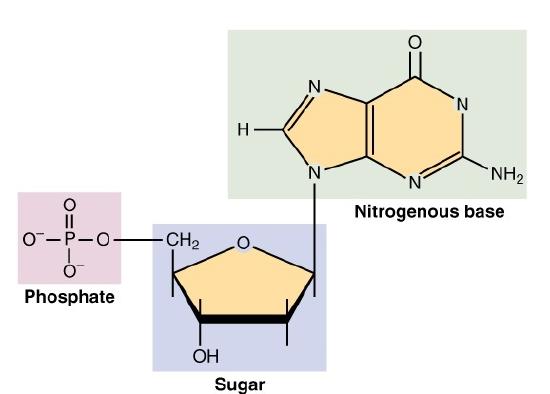
Nucleotides are connected to form DNA as shown in Figure \(\PageIndex{3}\). The sugar molecule of one nucleotide binds to the phosphate group of the next nucleotide. These two molecules alternate to form the backbone of the nucleotide chain. The nitrogen bases in a nucleic acid stick out from the backbone. There are four different nitrogenous bases: cytosine, adenine, guanine, and either thymine (in DNA) or uracil (in RNA). In DNA, hydrogen bonds form between bases on the two nucleotide chains and hold the chains together. Each type of base binds with just one other type of base: cytosine always bonds with guanine, and adenine always bonds with thymine. These pairs of bases are called complementary base pairs.
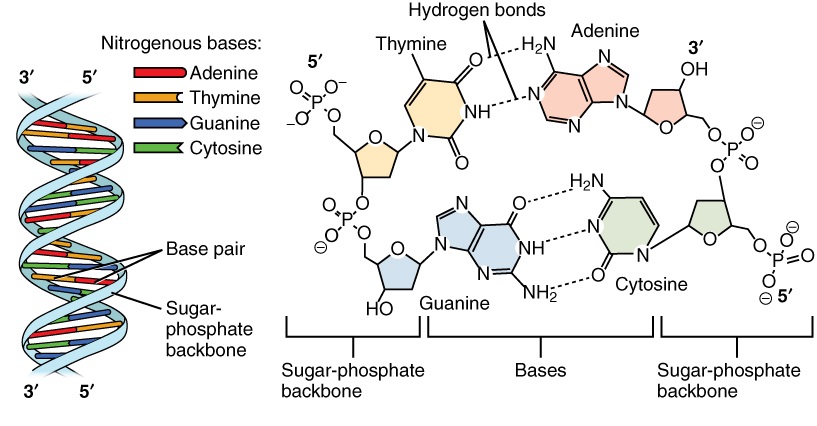
The hydrogen bonding of complementary bases causes DNA molecules automatically to take their well-known shape, called a double helix, which is shown in the animation in Figure \(\PageIndex{4}\). A double helix is like a spiral staircase. The double helix shape forms naturally and is very strong, making the two polynucleotide chains difficult to break apart.
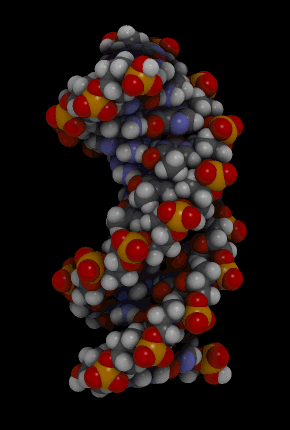
Roles of Nucleic Acids
The DNA of cells is organized into structures called chromosomes as shown in Figure \(\PageIndex{5}\). The letters A, T, G, and C stand for the bases adenine, thymine, guanine, and cytosine. The sequence of these four bases in DNA is a code that carries instructions for making proteins. The DNA helix is wrapped around proteins called histones to form nucleosomes. These are then further structured into chromatin and, finally, chromosomes. Human cells have 46 chromosomes; other organisms have different numbers of chromosomes.
DNA makes up genes, and the sequence of bases in DNA makes up the genetic code. Between “starts” and “stops,” the code carries instructions for the correct sequence of amino acids in a protein. The information in DNA is passed from parent cells to daughter cells whenever cells divide. The information in DNA is also passed from parents to offspring when organisms reproduce. This is how inherited characteristics are passed from one generation to the next.

Look at the Neanderthals in Figure \(\PageIndex{6}\). The image is an artist's reconstruction of these close human relatives, who seem to have disappeared from Europe some 50,000 years ago. The consensus that Neandertals were brutish and went extinct when overtaken by modern humans is undergoing revision as we learn more about these interesting members of the genus Homo.
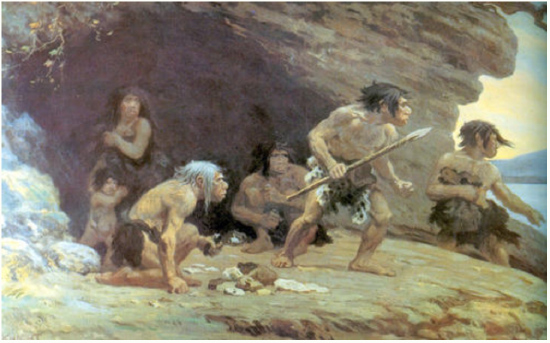
Several years ago, scientists were able to extract DNA from fossilized bones of Neanderthals (see Figure \(\PageIndex{7}\)). When the Neanderthal DNA was compared with modern human DNA, researchers discovered similarities in the DNA of Neanderthals and modern European-derived peoples that suggest modern humans mated with Neanderthals. Some experts now think that Neanderthals didn’t go extinct but were simply incorporated into the much larger population of Homo sapiens.
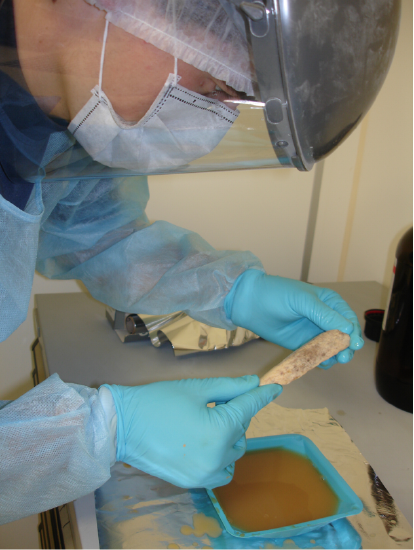
New research published in Science early in 2016 shows that our inherited Neanderthal DNA may be more than just an interesting curiosity or useful evidence of our evolutionary past. These bits of DNA may actually be affecting our health today. In the research reported in Science, scientists looked for Neanderthal DNA sequences in the DNA from an electronic database compiled from health records of almost 30,000 modern American adults. The scientists found that certain segments of Neanderthal DNA are especially common in people who have particular medical conditions, such as depression and increased amounts of blood clotting. Other bits of Neanderthal DNA seems to boost the immune response to certain parasites and other pathogens.
Most of the Neanderthal DNA segments that have persisted into our modern gene pool were probably beneficial in prehistoric times. Now, however, they may increase the risk of disease because our lifestyles and environments have changed so much since then. For example, an increase in blood clotting would have helped prevent life-threatening bleeding from injuries or childbirth in the past, but today it may increase the risk of blood clots and strokes in older people with sedentary lifestyles. Even immune-boosting bits of Neanderthal DNA may now do more harm than good for Americans who live in environments where there are far fewer parasites. They may make our immune systems overactive and cause allergies and autoimmune disorders.
Review
- What are the nucleic acids?
- How does RNA differ in structure from DNA?
- Describe a nucleotide. Explain how nucleotides bind together to form a polynucleotide.
- What role do nitrogen bases in nucleotides play in the structure and function of DNA?
- What is the role of RNA?
- Explain why Mark and Scott Kelly look so similar, using what you learned about nucleic acids in this article.
- True or False. A, C, G, and T represent the bases in RNA.
- True or False. The two polynucleotide chains of RNA twist into a double helix shape.
- True or False. Cytosine always binds to guanine in DNA.
- If part of a chain of DNA has the sequence of bases: ATTG, what is the corresponding sequence of bases that it binds to on the other chain?
- Arrange the following in order from the smallest to the largest level of organization: DNA; nucleotide; polynucleotide
- As part of the DNA replication process, the two polynucleotide chains are separated from each other, but each individual chain remains intact. Which bonds are broken in this process?
- Bonds between adjacent sugars and phosphate groups
- Bonds within nucleotides
- Bonds between complementary bases
- Bonds between adenine and guanine
- Adenine, guanine, cytosine, and thymine are:
- Nucleotides
- Nitrogenous bases
- Sugars in DNA and RNA
- Phosphate groups
- Some diseases and disorders are caused by genes. Explain why these genetic disorders can be passed down from parents to their children.
Explore More
Attributions
- Twins by Peter Voerman, licensed CC BY-NC 2.0 via Flickr.com
- DNA nucleotides by OpenStax, licensed CC BY 4.0 via Wikimedia Commons
- DNA nucleotides by OpenStax, licensed CC BY 4.0 via Wikimedia Commons
- DNA cropped by Jahobr, released into the public domain via Wikimedia Commons
- DNA macrostructure by OpenStax, licensed CC BY 4.0 via Wikimedia Commons
- Le Moustier, public domain via Wikimedia Commons
- Neanderthal DNA extraction by Max Planck Institute for Evolutionary Anthropology, public domain via Wikimedia Commons
- Text adapted from Human Biology by CK-12 licensed CC BY-NC 3.0


